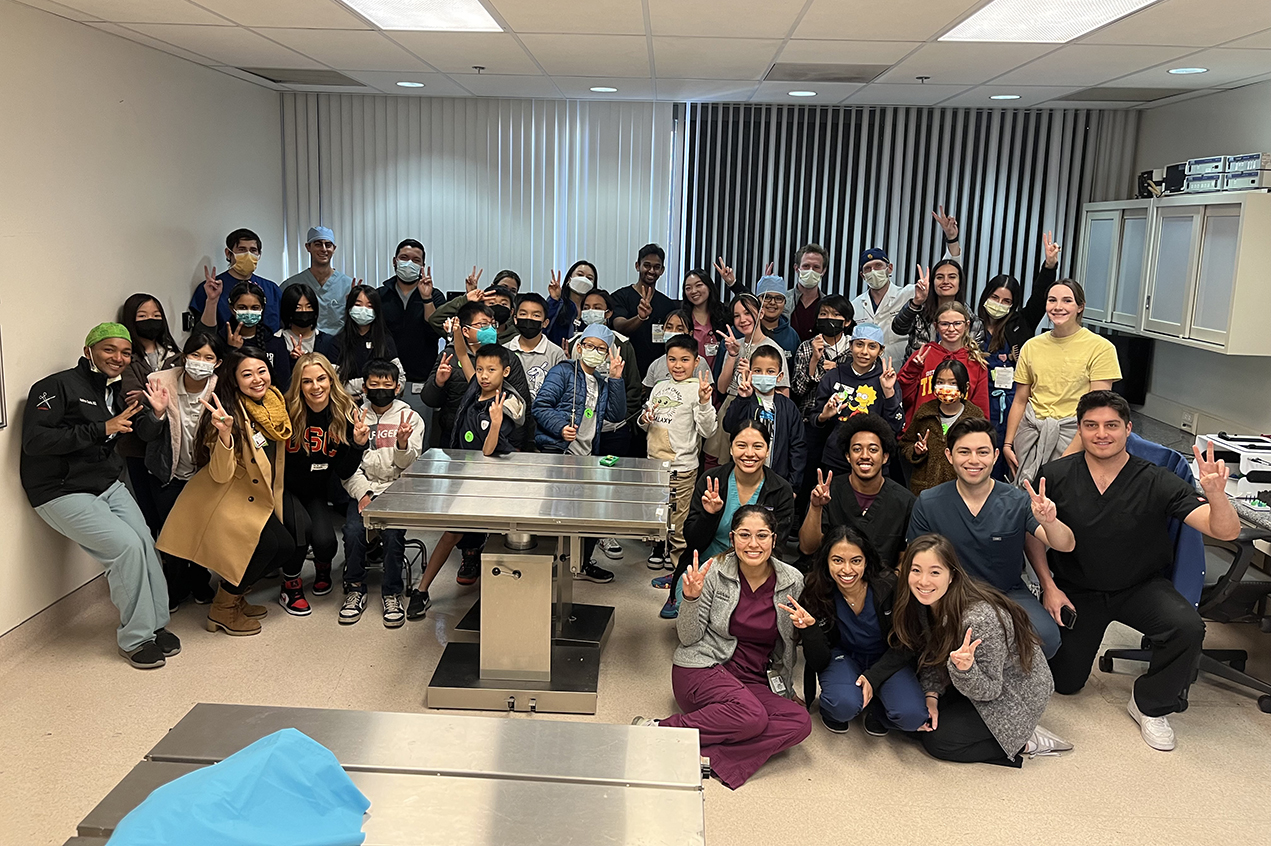This March the USC Surgical Skills and Education Center welcomed fifth- and sixth-grade students from Emma W. Shuey Elementary School in Rosemead.
At one learning station, students practiced moving small objects using laparoscopic surgical tools. At another, kids took ultrasounds of each other’s hearts and lungs. At another, a group learned about potential careers: surgeons, medical doctors, nurse practitioners and medical and surgical technicians. The kids rotated through the learning stations in small groups to ensure that they got personalized attention and could ask questions.
The students came to the Skills Center as a part of The Department of Surgery’s Surgeon for a Day program, organized by two surgical residents, Danielle Brabender, MD, and Jordan Wlodarczyk, MD, plus medical student Nathan Menard. The three brought their idea for the program to the Department of Surgery’s Diversity, Equity and Inclusion committee last year and received a grant to run the program and provide transportation and lunch for the students. The original goal was to run the program once a year, but the first Surgeon for a Day event last September was such a success that the group set this one up this March, just six months later.
The funding was a key part of the plan: The Surgeon for a Day program is designed for students at under-resourced schools, so every aspect is designed to remove barriers. “It’s all taken care of,” explained Damon Clark, MD, the chairman of the Department of Surgery’s DEI committee. “We want to make sure that money is not an obstacle and location is not an obstacle.”
A key part of the program was getting the students to see themselves as potential doctors and think about career paths in medicine as real possibilities. The Surgeon for a Day team deliberately chose an elementary school with a high population of students from marginalized communities.
“The research we looked at showed us that the lack of diversity in medicine isn’t something that starts in college or even high school,” Menard said. “We learned that marginalized kids have already stopped thinking of themselves as potential doctors by the time they get to junior high.”
And the problem keeps getting worse, as Brabender explained: “You have to think of it like a leaky pipeline: Every year, you lose a few more kids.”
In the Surgeon for a Day program, the students don’t just try out the learning stations; they meet attending surgeons, residents and medical students, who interact with them as potential colleagues.
“This can change the way these kids see themselves,” Wlodarczyk said. “It can open up pathways they didn’t know were there.”
That’s one of the reasons the organizers felt it was important to bring the kids to campus. “Yes, we could have gone to their classrooms and given a talk, but it’s important that they’re physically present here,” Menard said. “It’s one thing to be told you belong; it’s very different to be there.”
Clark agreed. “Kids learn by what they see and what they hear. I wish I had seen this at that grade level. I grew up in an area that had some challenges. I always liked science and I liked the idea of being able to help people. I want these kids to see that if I can do it, they can do it.”
The career station is an important part of the journey for the students. They get to ask questions and learn about what a day on the job is like in different medical careers, and they learn how many options they have.
“Obviously, as a surgeon, I’m a little biased and I want these kids to grow up to be surgeons,” Wlodarczyk said. “But the idea here is to show them that there are lots of pathways for them. If they love science but they don’t love the idea of the extra ten-plus years of schooling, we want them to know that they can have a great career in medicine as a nurse or a technician or any number of things.”
The program seems to be just as beneficial for the volunteer surgical residents and medical students who get to spend the day with the kids. “They have so much energy, and they ask great questions. You can see the change in them,” Brabender said. “You can see them get excited about science.”
Everyone had high praise for the Skills Center staffers, lab technician Tiffany Barajas and clinical laboratory manager Angela Martinez. “They were so enthusiastic,” said Brabender, “And they really put together a great day for the kids.”
The first two events have been such a success that there is interest from schools across the Los Angeles area, and the program organizers are hoping to have an event every six months or even quarterly. There is also enough interest among the medical student and resident volunteers that the team has high hopes that the program will continue indefinitely.
The most important reaction, of course, is from the program participants. Clark noted that “At the end of our session, a teacher asked the kids which field trip was their favorite: Our Surgeon for a Day workshop or their trip to a Dodgers game. They picked us. That felt pretty good.”
— Lex Davis


